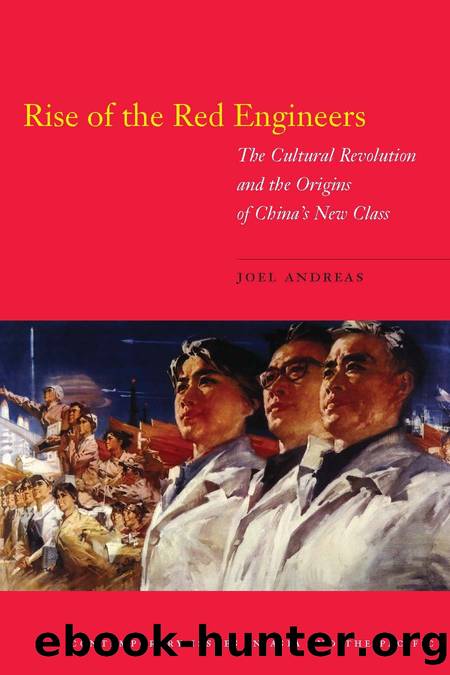Rise of the Red Engineers by Andreas Joel

Author:Andreas, Joel.
Language: eng
Format: epub, pdf
Publisher: Stanford University Press
Published: 2011-08-16T00:00:00+00:00
Redistributing Access to Education
The agenda of the Cultural Revolution in terms of redistributing access to education was very ambitious. The goal was to level the education pyramid, compressing the top downward, and building up the base, creating a flat system that distributed educational attainment equally across the population. The number of primary and middle schools was expanded at a breakneck pace, especially in rural areas, with the aim of making both primary and secondary education universal in a short period of time.10 Although regional variation was encouraged, all schools were supposed to be equivalent in terms of quality. The keypoint system of selective college preparatory schools was eliminated, and these schools, along with the special schools that had catered to cadresâ and military officersâ children or had been reserved for children of university employees, were converted into regular neighborhood schools. As a result, the middle school attached to Tsinghua University was required to open its doors to an influx of graduates from primary schools in neighboring villages. The length of schooling was shortened. In many areas, primary school was cut from six to five years, and middle school education was typically reduced by one or two years. Previously, students had taken entrance exams starting in the fourth grade of primary school to determine whether they were qualified to continue to the next level of education and whether they would attend a keypoint or a regular school. Now, by making primary and secondary education universal and by making all schools nominally equal in terms of quality, there would no longer be a purpose for entrance examinations.11 All children were supposed to attend school for nine or ten years and then go to work.
In terms of this goal, the results were impressive. Before 1966, less than half of Chinese children completed primary school, only about 15 percent completed junior middle school, and less than 3 percent completed senior middle school. By the end of the Cultural Revolution decade, almost all children completed primary school, over two-thirds completed junior middle school, and well over one-third completed senior middle school.12 These figures, of course, require qualification: the years of schooling were cut, and education standards had declined.13 Nevertheless, the rapid expansion of basic education during the Cultural Revolution decade allowedâfor the first timeâthe great majority of Chinese children to complete primary school and attend middle school.14 The consequences of the Cultural Revolutionâs social-leveling program in education were, of course, very different at the top. While educational opportunities for rural children were greatly expanded, the opportunities available to children of urban elites were painfully curtailed. Many children from intellectual and revolutionary cadre families had grown up expecting to attend keypoint middle schools and universities, which were now eliminated or fundamentally altered by harsh anti-elitist policies.
Tertiary education presented a difficult dilemma for Maoâs cultural-leveling project. Making middle school education universal was a feasible short-term goal; for the foreseeable future, however, only a small fraction of the population would be able to attend college. For this reason, Mao was uncomfortable with the entire idea of university education.
Download
This site does not store any files on its server. We only index and link to content provided by other sites. Please contact the content providers to delete copyright contents if any and email us, we'll remove relevant links or contents immediately.
The European History Highway: A Guide to Internet Resources by Dennis A. Trinkle Scott A. Merriman(494)
The Seven Wonders of the Ancient World by Michael Denis Higgins(477)
European Security in a Global Context by Thierry Tardy(470)
European Security without the Soviet Union by Stuart Croft Phil Williams(469)
The Routledge companion to Christian ethics by D. Stephen Long Rebekah L. Miles(458)
Hudud Al-'Alam 'The Regions of the World' - a Persian Geography 372 A.H. (982 AD) by V. V. Minorsky & C. E. Bosworth(399)
Gorbachev And His Generals by William C. Green(391)
Get Real with Storytime by Julie Dietzel-Glair & Marianne Crandall Follis(390)
Tibetan Studies in Comparative Perspective by Chih-yu Shih Yu-Wen Chen(385)
Governance, Growth and Global Leadership by Espen Moe(381)
Hyperculture by Byung-Chul Han(378)
CliffsNotes on Fitzgerald's The Great Gatsby by Kate Maurer(360)
The Oxford History of the World by Fernández-Armesto Felipe;(354)
How Languages Are Learned 5th Edition by Patsy M Lightbown;Nina Spada; & Nina Spada(352)
The Egyptian Economy, 1952-2000 by Khalid Ikram(352)
Oral Poetry and Narratives from Central Arabia: The Poetry of Ad-Dindan : A Bedouin Bard in Southern Najd (Studies in Arabic Literature, Vol 17) (English and Arabic Edition) by P. M. Kupershoek P. Marcel Kurpershoek(343)
The Oxford Handbook of the Incas by Sonia Alconini(333)
Europe Contested by Harold James(319)
The Hutchinson Dictionary of Ancient and Medieval Warfare by Peter Connolly John Gillingham John Lazenby(305)
